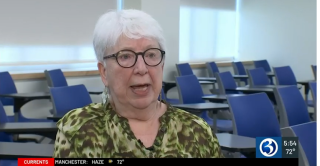
Meningococcal Disease
(The Menactra Vaccine)
What is Meningococcal Disease?
Meningococcal Disease is a rare but potentially life threatening bacterial infection that requires immediate treatment. The bacterium, Neisseria meningitidis, is the responsible germ which can manifest in one’s body as meningitis (an inflammation of the thin lining of the brain and spinal cord), septicemia (blood poisoning) as well as arthritis and pneumonia.
Who can get meningococcal disease?
Anyone can get meningococcal meningitis, but it is more common in infants, children and young adults. The Center for Disease Control (CDC) surveillance reports over the last several years suggest increasing incidence of outbreaks on college campuses. Because of this, the American College Health Association (ACHA) recommends that colleges and universities inform all students about the availability of a safe, effective vaccine and provide access to the vaccine for those students who wish to be vaccinated against the disease. The CDC supports the decision of the ACHA to educate students and parents about this disease and the available access to the vaccine.
Approximately 10% of the general population carries meningococcal bacteria in their noses and throats in a harmless state. The carrier state may last for days or months before it disappears spontaneously.
These carriers who harbor the bacteria in their upper respiratory tracts (nose and throats) may have some protection against developing actual meningococcal disease.
The most common manifestation of this disease is meningococcal meningitis. Meningococcal meningitis is responsible for approximately 300 deaths a year.
Who is at risk for meningitis?
It is a relatively rare disease. Clusters of cases or outbreaks of meningococcal disease (three or more people with the same bacteria type causing the disease) have occurred. During an outbreak, the percentage of people carrying the bacteria may approach 95%, yet the percentage of people who actually develop meningococcal disease is less than 1%.
Students living in the confined environment of a college campus may have an increased risk for this disease. Data indicates that social behaviors, such as exposure to passive and active smoking, bar patronage and excessive alcohol consumption also increase students risk of getting the disease. Outbreaks usually occur in the late winter and early spring when school is in session.
When and for how long is an infected person able to spread the disease?
From the time a person is first infected until the germ is no longer present in discharges from the nose and throat, he or she may transmit the disease. The duration varies according to treatment used.
What are the symptoms of meningitis?
The symptoms include sudden onset of fever, intense headache, nausea and often vomiting, stiff neck and frequently a rash. The symptoms may appear 1 to 10 days after exposure, but commonly less than 4 days after exposure.
How can I reduce the risk of getting the disease?
Meningococcal disease is spread through the exchange of nose or throat secretions via:
-
Sharing the same drinking utensil (cup, bottle, glass, can or jug)
-
Sharing the same mouthpiece of an instrument (trumpet, clarinet)
-
Sharing the same eating utensil.
-
Sharing the same cigarette, cigar etc.
-
Sneezing or coughing in someone’s face
-
Sharing the same chapstick or lipstick
-
Kissing.
How can I reduce the risk of getting the disease? (continued)
Break the chain of transmission of Meningococcal disease
-
Use your own drinking/eating utensils
-
Use your own instrument mouthpiece
-
Cover your nose and mouth with a tissue or your hands when sneezing or coughing.
-
Throw away the tissue and wash your hands
-
Don’t share cigarettes or cigars, etc.
-
Don’t share chapstick or lipstick.
What is the treatment for meningococcal meningitis?
Certain antibiotics are very effective in eliminating the germ from the nose and throat. Penicillin is the drug of choice for cases of meningitis.
Should people who have had contact with a diagnosed case of meningococcal meningitis be treated?
Only people who have been in close contact (household members, intimate contacts, health care personnel performing mouth to mouth resuscitation, day care center playmates etc.) need preventive treatment. These contacts would be advised to take a specific medication for a two day period.
Casual contact (in a classroom or office) is not usually significant to warrant preventive medication.
How effective is the vaccine to prevent the disease?
The meningococcal vaccine (MCV4) has been shown to be safe and effective. The vaccine provides protection against serogroups A,C,Y,W-135, the most common strains of the disease. a majority of cases (75 percent) in the college age group are caused by Serotype C, which is included in the vaccine. Development of immunity post vaccination requires 7-10 days. The duration of the vaccine’s efficacy is approximately three to five years.
Who should be vaccinated for the prevention of the disease?
- Two doses of MCV4 are recommended for adolescents 11 through 18 years of age: the first dose at 11 or 12 years of age, with a booster dose at age 16.
- Adolescents in this age group with HIV infection should get three doses: 2 doses 2 months apart at 11 or 12 years, plus a booster at age 16.
- If the first dose (or series) is given between 13 and 15 years of age, the booster should be given between 16 and 18. If the first dose (or series) is given after the 16th birthday, a booster is not needed.Pre- exposure vaccination will enhance immunity to the bacteria that cause most strains of meningococcal disease.
- Vaccination with MCV4 is required for all students living in Residence Halls.
Meningococcal disease is rare. However, anyone who becomes ill with mild flu like symptoms should watch for the sudden onset of increased fever (101 or greater) with headache, vomiting, rash or change in mental state. If any of these additional symptoms develop, do not delay in seeking medical attention.



